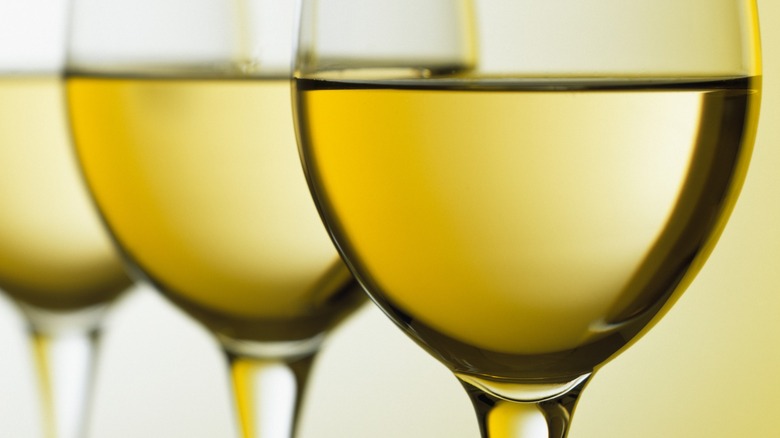The Best Bottles Of White For Making Mulled Wine
We may receive a commission on purchases made from links.
Folks have been enjoying mulled wine since ancient Roman times, but to give this historical crowd-pleaser a modern facelift, it's time to break out the white wine — specifically, bottles of Chardonnay, Sauvignon Blanc, or Pinot Grigio. Classic cozy mulled wine traditionally melds a dark, dry red wine with mulling spices, sugar, and a full-proof spirit, often brandy, bourbon, amber rum, or Cognac. Fans expect this steaming sipper to appear bobbing with chunks of fruit, navel orange wheels, whole cloves, star anise, and cinnamon sticks.
But, believe it or not, the dark burgundy-red hue is totally optional, here. This tip comes from Derek Crow, lead bartender at Bar Zazu in Resorts World Las Vegas. Crow recently took home first place in the prestigious 2024 Cardenal Mendoza Gold Jigger Cocktail Competition in Spain (and inversion of traditional reds for avant-garde whites might be a go-to mixology tip for the bartender, considering there's currently a Sangria Blanco on Bar Zazu's cocktail menu).
To switch up your mulled wine this cold-weather season, says Crow, try whipping up a batch of the warming cocktail using white wine instead of the red wines typically used in mulled wine. "Personally, I prefer using a dried or slightly oaky wine like a Sauvignon Blanc, Pinot Grigio, or even a Chardonnay if the first two aren't available," Crow explained in an exclusive interview with Tasting Table. "These make a great base for flavor to build off of — wines that have a more neutral flavor as a base are typically easier to build off."
White wine is the perfect base for mulled wine
Sauvignon Blanc's crisp acidity, Pinot Grigio's mild citric tartness, and Chardonnay's low-tannic dryness are all a smart move for manipulating the sweetness level in a mug of mulled wine. While none of these are on the list of the best wine types to use for mulled wine, as Derek Crow elaborates, "Wines that are too sweet can hinder the cocktail and dampen all the other flavors. Most mulled wine recipes call for sugar anyway, so using a sweet wine can create an overly sweet cocktail that will make the drink a one and done."
When used to make and serve mulled wine, Crow's accessible trio also increases overall drinkability, which can be a great move for entertaining or hosting holiday parties. Quoth Crow, "I and many others prefer something I can sip and enjoy and maybe even refill and enjoy another. The recommended white wines are still flavorful enough that they still shine through without getting lost in all of the spices that it simmers with." Keeping it subtle ultimately creates a multi-layered profile.
Mulled wine can be fortified as often as not. If you choose to spike it with a full-proof spirit, keep in mind that brown liquors are going to pair better with bold red wines. For white mulled wine, stick to light spirits like spiced rum, sherry, or flavorless vodka to let the wine's tasting profile shine. You could also emphasize the white wine's natural fruity acids by loading your mulled wine with golden apples, pears, and lemon peel.

